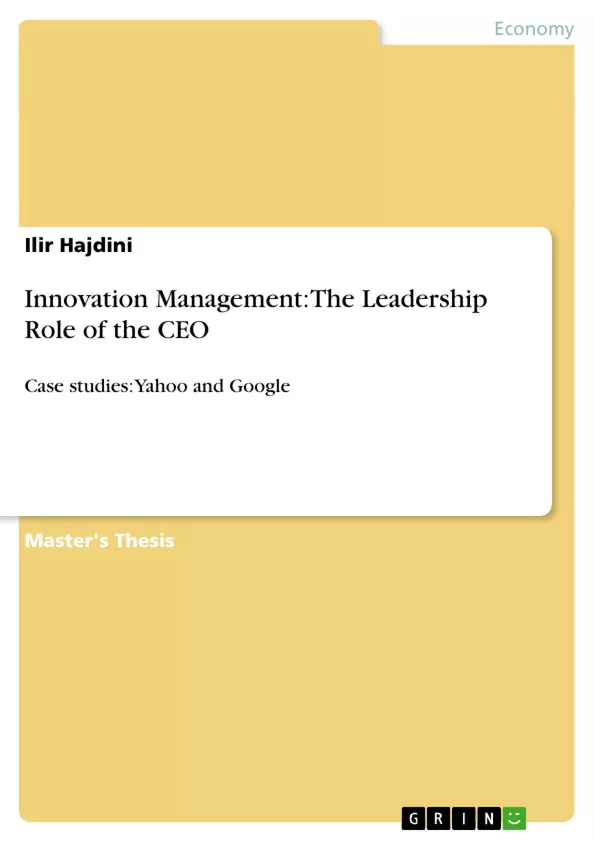The research plans to show the importance of the leadership role of the Chief Executive Officer (CEO) in Managing Innovation. This has also attracted the focus of researchers analysing leadership styles and its relation to innovation. Innovation is a transition from traditional methods to modern ways of providing products, services, processes, business models and much more. However, factors that have continuously kept innovation ever-increasing have not yet been clearly identified. Effectively, CEOs have their own role in the process of managing innovation allowing, initiating and monitoring the processes, products, services offered by public or private sectors. Therefore, this dissertation plans to compare the CEOs leadership role in two leading online world companies Yahoo and Google that are rapidly facing the growing demands for modernisation of their offerings. The comparison will attempt to test a hypothesis that relates Yahoo and Google CEOs’ role in selection of strategy, acquisitions and management style, and its effect in innovation outcomes.
Inhaltsverzeichnis (Table of Contents)
- Overview of the research
- Introduction
- Literature Review
- Current CEO Practitioner Views
- Academic Research
- Research methodologies
- Research hypothesis
- Data collection
- Brief History of Yahoo until 2001
- Terry Semel's Role in Managing Innovation at Yahoo
- Strategy and structure
- Management Style
- Acquisitions and partnerships
- Financial Results
- Brief History of Google until 2001
- Eric Schmidt's Role in Managing Innovation at Google
- Strategy and structure
- Management Style
- Acquisitions and partnerships
- Financial Results
- Innovation outcomes
- Discussion
- Recommendation for Companies
- Limitations and Recommendations for further research
Zielsetzung und Themenschwerpunkte (Objectives and Key Themes)
This research explores the critical role of the Chief Executive Officer (CEO) in managing innovation within organizations, particularly in the context of leading online companies. The study aims to analyze and compare the leadership styles, strategic approaches, and management practices of Yahoo and Google CEOs, examining their impact on innovation outcomes.- The importance of CEO leadership in driving innovation.
- The role of strategy, acquisitions, and management style in fostering innovation.
- The impact of CEO leadership on innovation outcomes, specifically comparing Yahoo and Google.
- The analysis of the effectiveness of different approaches to innovation management.
Zusammenfassung der Kapitel (Chapter Summaries)
- Overview of the research: This chapter introduces the research's focus on the CEO's role in managing innovation, highlighting the importance of innovation in today's business environment and the specific focus on Yahoo and Google.
- Introduction: This chapter provides a general introduction to the concept of innovation, its significance in the business world, and its importance for organizations to thrive in a dynamic environment.
- Literature Review: This chapter provides a comprehensive overview of existing literature on innovation management, exploring various theoretical perspectives and frameworks relevant to the research topic.
- Current CEO Practitioner Views: This chapter delves into insights and perspectives from leading CEOs regarding their experiences and approaches to managing innovation within their respective organizations.
- Academic Research: This chapter provides an overview of academic research findings related to innovation management, particularly focusing on the role of leadership and its impact on innovation outcomes.
- Research methodologies: This chapter outlines the research methodology employed in the study, detailing the research hypothesis, data collection methods, and analytical techniques utilized to gather and interpret data.
- Brief History of Yahoo until 2001: This chapter provides a historical overview of Yahoo's journey, highlighting key milestones and factors that shaped its growth and evolution as an online company.
- Terry Semel's Role in Managing Innovation at Yahoo: This chapter examines Terry Semel's leadership role at Yahoo, exploring his strategic decisions, management style, approach to acquisitions and partnerships, and the financial performance of the company during his tenure.
- Brief History of Google until 2001: This chapter provides a historical overview of Google's journey, highlighting key milestones and factors that shaped its growth and evolution as an online company.
- Eric Schmidt's Role in Managing Innovation at Google: This chapter examines Eric Schmidt's leadership role at Google, exploring his strategic decisions, management style, approach to acquisitions and partnerships, and the financial performance of the company during his tenure.
- Innovation outcomes: This chapter compares and contrasts the innovation outcomes achieved by Yahoo and Google, analyzing the impact of the different leadership styles and management approaches employed by their CEOs.
- Discussion: This chapter provides a comprehensive analysis of the findings from the study, drawing conclusions about the role of CEO leadership in managing innovation, the effectiveness of different strategies, and the impact on innovation outcomes.
- Recommendation for Companies: This chapter offers practical recommendations for companies seeking to enhance their innovation capabilities, drawing insights from the study's findings and best practices identified in the analysis of Yahoo and Google.
- Limitations and Recommendations for further research: This chapter acknowledges limitations of the study and suggests areas for future research to further explore and expand upon the findings of the study.
Schlüsselwörter (Keywords)
This study focuses on the critical role of CEO leadership in managing innovation within organizations, specifically comparing Yahoo and Google. Key areas of exploration include the leadership styles, strategic decisions, management approaches, and their impact on innovation outcomes. The analysis considers factors such as acquisitions, partnerships, and financial performance as indicators of innovation success. The study aims to provide insights into the crucial connection between CEO leadership and innovation, offering practical implications for organizations seeking to enhance their innovation capabilities.- Citation du texte
- Ilir Hajdini (Auteur), 2009, Innovation Management: The Leadership Role of the CEO, Munich, GRIN Verlag, https://www.grin.com/document/146838



